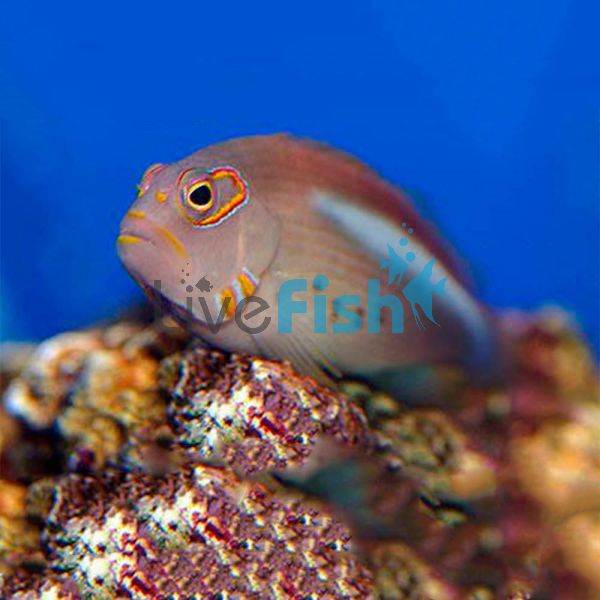Arc Eyed Hawkfish - Medium
This is hardy fish with plenty of personality. They usually fit in best in a tank with other larger semi-aggressive to aggressive species.
Arc Eyed Hawkfish’s
The Arc Eyed Hawkfish’s body can be a variety of colors ranging from greenish-brown, reddish-orange, or brown. It also has a thick white line running along the lateral line down the back half of its body to its tail which is usually clear to blueish in color. It also has a yellowy-orange, whitish-blue and red U-shaped marking around the back of the eyes. It also has three yellowy-orange bands on a light bluish-white area of the interoperable.
These fish are voracious predators are very territorial. They spend most of their time perched on corals, waiting for unsuspecting prey to approach too close.
The Arc Eyed Hawkfish has a very aggressive temperament and may harass fish that are introduced to a tank after it. They do not discriminate which fish they are aggressive to and will be aggressive even to fish that are larger than themselves.
This species can change gender from female to male, so if the dominant male disappears then a female changes sex and takes on the role. They can live as a pair provided they are introduced simultaneously. You can also keep several Arc Eyed Hawkfish together, but sometimes they will suddenly begin to fight after some time in the aquarium. This may be due to the changing gender so that two males are present in the group.
They live in shallow waters in the tropical Indo-Pacific region. They are found in East Africa to the Hawaiian Islands, north to southern Japan, south to northern and eastern Australia and are usually found in lagoons and on seaward facing reefs, often resting on coral heads waiting for prey.
Tank Recommendations for Arc Eyed Hawkfish
Hawkfish spend a lot of time staying still resting on corals in the wild waiting for food. This does make them suitable for smaller aquariums. They still need an aquarium that is at least 114 liters for one specimen, so increase the tank size if planning to keep more than one individual.
They need plenty of hiding places in the tank, live rock will work well for this. They also appreciate corals that they can perch themselves on. They have been known to eat anemones as well as invertebrates so be careful if keeping them in a reef tank. The substrate for these fish isn’t important for these fish.
Suitable Tank Buddies
This species can be extremely aggressive towards other fish, so it’s not really suitable for keeping with peaceful or docile species. They may also eat snails, shrimp, crabs, and small fish.
Usually Compatible
Larger semi-aggressive or aggressive fish are the most suitable tank buddies like Butterflyfish, Tangs, Hogfish, and Scorpionfish. You can also keep them with other Arc Eyed Hawkfish so long as they are either a mated pair or a single male with multiple females.
Sometime Compatible
Take care when housing them with Anglerfish, Wrasses, Triggerfish. They can often be Boxfish and Large Angelfish so long as they are introduced to the tank before the Arc Eyed Hawkfish.
Rarely Compatible
Don’t keep these fish with Seahorses or Pipefish as they are far too aggressive. Don't keep them with smaller fish like Damselfish either as they are likely to eat them. Eels, Groupers, Sharks, and Snappers are all likely to view the Hawkfish as a meal so they shouldn't be kept together either.
Feeding Your Arc Eyed Hawkfish
These fish are carnivorous and in the wild, they will eat small crustaceans like krill and mysis shrimp as well as small fish and crabs. In the aquarium, they will eat live foods like mysis and brine shrimp, but you can also feed them frozen diced fish and shrimp.
We recommend feeding them either once or twice per day, as this can help curb their aggression. Adjust the feeding frequency depending on if they clear all of the meals that you offer them.
| Scientific Name | Paracirrhites Arcatus |
|---|---|
| Care Level | Easy |
| Common Names | Arc-eye Hawkfish, Horseshoe Hawkfish, Ring-eye Hawkfish , Whiteline Hawkfish, Ringeyed hawkfish, Ring-eyed hawkfish and Ringeye hawkfish |
| Diet | Carnivore |
| Fish Family | Paracirrhites |
| Lifespan (years) | 8 |
| Max. Length (cm) | 20 |
| Min. Tank Volume (l) | 114 |
| Origin | East Indian Ocean, West Indian Ocean, Australia, Japan, Indonesia, East Pacific, Central/West Pacific |
| Reef Safe | With Caution |
| Sociability | Aggressive |
| Venomous | No |
| Water Conditions | 22.2-25.6°C (72-78° F), dKH 8-12, pH 8.1-8.4, sg 1.020-1.025 |




